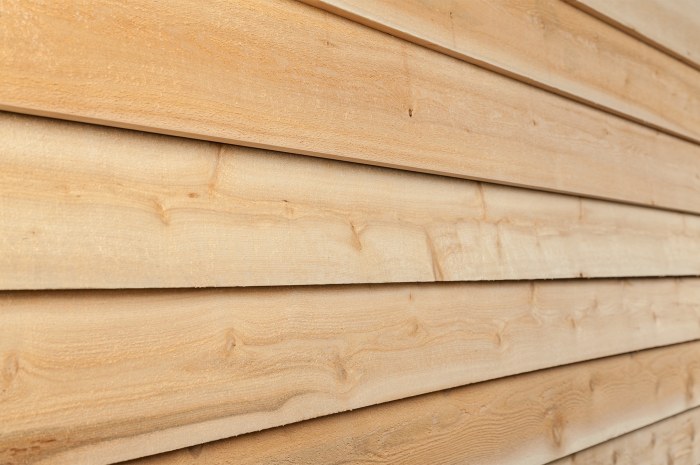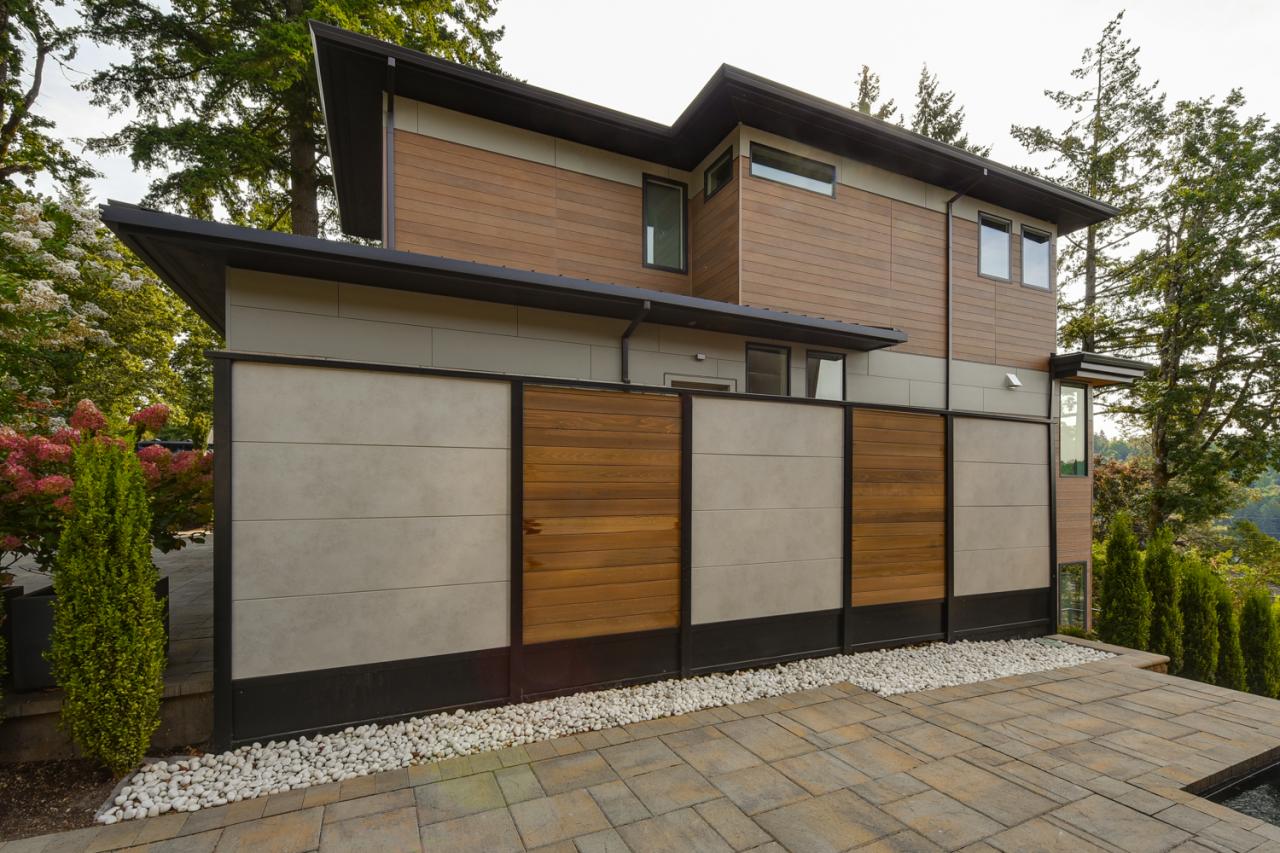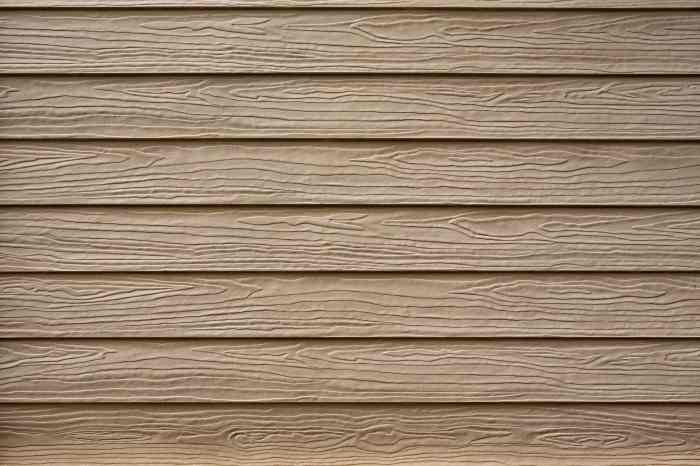Hardie wood siding offers a compelling blend of aesthetics and durability, making it a popular choice for homeowners seeking a low-maintenance, long-lasting exterior. This comprehensive guide delves into every aspect of Hardie wood siding, from its composition and installation to its cost, maintenance, and environmental impact. We’ll explore the advantages over traditional wood and vinyl siding, providing you with the knowledge to make an informed decision for your next home improvement project. Understanding the nuances of this material is key to maximizing its benefits and ensuring a successful installation.
We’ll cover everything from choosing the right color and texture to addressing common issues and performing necessary repairs. Whether you’re a seasoned DIYer or planning to hire a contractor, this guide provides the essential information you need to confidently navigate the world of Hardie wood siding.
Hardie Wood Siding

HardiePlank® siding, a popular choice for homeowners, offers a durable and aesthetically pleasing alternative to traditional wood siding. This fiber cement siding provides a long-lasting, low-maintenance exterior for homes, resisting many of the challenges posed by other materials. Understanding its composition, durability, and maintenance requirements is crucial for making an informed decision about its suitability for your home.
Hardie Wood Siding Composition and Manufacturing
Hardie wood siding, primarily manufactured by James Hardie, is a composite material consisting of cement, cellulose fibers, and other additives. The cellulose fibers, often derived from recycled wood pulp, provide tensile strength and flexibility to the mixture. The cement acts as a binder, providing the necessary hardness and durability. Other additives, such as mineral fillers and color pigments, enhance the product’s properties and aesthetics. The manufacturing process involves mixing these ingredients, forming them into the desired shapes and profiles, and then curing them under controlled conditions to achieve the final product’s strength and density. This process results in a siding that mimics the look of wood but offers significantly improved performance characteristics.
Durability Comparison: Hardie Wood Siding vs. Traditional Wood and Vinyl Siding
Hardie wood siding demonstrates superior durability compared to both traditional wood and vinyl siding. Unlike traditional wood, it is highly resistant to rot, insect infestation (such as termites), and fungal growth. Its cement composition renders it impervious to moisture damage, a significant advantage in regions with high humidity or frequent rainfall. Compared to vinyl siding, Hardie wood siding offers greater resistance to impact damage and less susceptibility to warping or fading in harsh sunlight. While vinyl may be cheaper initially, Hardie siding’s longevity often translates to lower long-term costs associated with repairs and replacements. The improved durability also contributes to a longer lifespan, reducing the frequency of replacement needs.
Hardie Wood Siding Maintenance
Regular maintenance ensures the longevity and aesthetic appeal of Hardie wood siding. While it requires less upkeep than traditional wood, periodic cleaning and occasional painting are recommended. Repair procedures are straightforward for minor damage, but major repairs might require professional assistance.
| Maintenance Task | Frequency | Materials Needed | Procedure |
|---|---|---|---|
| Cleaning | Annually or as needed | Garden hose, soft-bristled brush, mild detergent (optional) | Rinse the siding with a garden hose to remove loose dirt and debris. For stubborn stains, use a soft-bristled brush and a mild detergent solution. Rinse thoroughly afterward. |
| Painting (if needed) | Every 5-15 years, depending on climate and paint type | Primer suitable for fiber cement, exterior paint, brushes or sprayer, painter’s tape (optional) | Prepare the surface by cleaning and allowing it to dry completely. Apply a primer specifically designed for fiber cement siding. Once the primer is dry, apply two coats of high-quality exterior paint, allowing sufficient drying time between coats. |
| Repairing Minor Damage | As needed | Caulk, putty knife, matching paint | Clean the damaged area. For small cracks or holes, apply caulk or patching compound, smoothing it with a putty knife. Once dry, paint to match the surrounding siding. |
Hardie Wood Siding
Hardie® wood siding offers a durable and aesthetically pleasing alternative to traditional wood siding. Its fiber cement composition provides superior resistance to rot, insects, and fire, making it a long-term investment for homeowners. This guide delves into the installation process, design options, and provides examples of different house facade designs using Hardie siding.
Hardie Wood Siding Installation
Proper installation is crucial for ensuring the longevity and performance of Hardie wood siding. Begin by carefully reviewing the manufacturer’s instructions, as specific techniques may vary depending on the siding profile and chosen installation method. Always prioritize safety throughout the process.
- Preparation: Start by measuring and marking the areas to be sided. Ensure a solid, level surface. Existing siding must be removed completely. Inspect the sheathing for any damage and repair as needed. Establish a consistent nailing pattern, following manufacturer’s guidelines.
- Tools and Materials: Gather necessary tools, including a measuring tape, circular saw, safety glasses, work gloves, nail gun (with appropriate nails), level, chalk line, and safety harness (if working at heights). Ensure you have enough siding to cover the entire area, plus extra for cuts and waste.
- Installation: Begin at a corner or a prominent point, working your way across. Always pre-drill holes for screws or nails to prevent splitting. Maintain consistent spacing between siding panels. Use appropriate fasteners and ensure they are driven straight and flush to avoid damage.
- Flashing and Caulking: Proper flashing is essential around windows, doors, and other openings to prevent water penetration. Caulk all seams and joints to ensure a weathertight seal. Use high-quality exterior-grade caulk.
- Finishing Touches: Once the siding is installed, inspect for any gaps or imperfections. Repair as needed. Consider adding trim and accessories to enhance the overall aesthetic appeal.
Hardie Wood Siding Design Options
The versatility of Hardie wood siding allows for a wide range of design possibilities. Careful consideration of color, texture, and installation patterns can significantly impact the overall appearance of a home.
- Colors: Hardie siding is available in a vast array of colors, from classic neutrals to bold and vibrant hues. Consider the architectural style of your home and the surrounding landscape when selecting a color palette.
- Textures: Different textures, such as smooth, woodgrain, or cedar-shake, can add depth and visual interest. Choose a texture that complements the overall design aesthetic.
- Installation Patterns: The way the siding is installed can dramatically alter the look. Options include horizontal, vertical, or even diagonal patterns, each creating a distinct visual effect. Consider using different patterns on different parts of the house for visual interest.
House Facade Designs Using Hardie Wood Siding
Here are three distinct house facade designs showcasing the versatility of Hardie wood siding:
- Modern Farmhouse: This design utilizes a combination of deep gray and creamy white Hardie siding. The main body of the house is clad in the deep gray with a smooth texture, while the trim around windows and doors is accented with the creamy white. Vertical siding is used on a portion of the exterior to add visual interest, while horizontal siding covers the majority of the house. The overall aesthetic is clean, sophisticated, and inviting.
- Coastal Cottage: This design features a light, airy feel using a combination of soft blues and crisp whites. The main body of the house is clad in a light blue Hardie siding with a subtle woodgrain texture, giving it a natural, weathered look. White trim around the windows and doors provides a striking contrast. The use of horizontal siding creates a classic coastal aesthetic. Shingle-style siding is used on gables to add a touch of traditional charm.
- Traditional Colonial: This design embraces classic elegance with a deep, rich brown Hardie siding. The deep brown provides a stately appearance, complementing traditional architectural details. White trim is used sparingly to highlight key architectural features. The use of horizontal lap siding creates a classic, timeless look. A subtle woodgrain texture adds depth and visual interest.
Hardie Wood Siding
Hardie® wood siding offers a compelling blend of aesthetics and durability, mimicking the look of natural wood while providing superior protection against the elements. This makes it a popular choice for homeowners seeking a long-lasting, low-maintenance exterior. Understanding the costs involved and the long-term value proposition is crucial for making an informed decision.
Hardie Wood Siding Costs and Associated Factors
Several factors influence the overall cost of installing Hardie wood siding. These include material costs, labor expenses, and potential additional expenditures. A comprehensive understanding of these components allows for accurate budgeting and realistic cost projections.
| Cost Factor | Description | Average Cost | Notes |
|---|---|---|---|
| Material Costs | The cost of the Hardie® siding itself, including the specific type chosen (e.g., planks, panels, shingles), color, and quantity needed. | $3-$8 per square foot | Prices vary based on product type, color, and regional availability. Bulk purchases may offer discounts. |
| Labor Costs | Costs associated with professional installation, including preparation, installation, and cleanup. | $3-$6 per square foot | Labor costs can vary significantly depending on location, project complexity, and the installer’s experience. |
| Underlayment/Preparation | Costs for necessary materials such as house wrap, flashing, and any required repairs to the existing siding before installation. | $1-$3 per square foot | This cost is highly dependent on the condition of the existing wall structure. Significant repairs will increase this cost. |
| Trim and Accessories | Costs for additional materials like trim boards, corner pieces, and fasteners. | $1-$2 per linear foot | The amount of trim needed will vary depending on the house design and complexity. |
| Permits and Inspections | Costs associated with obtaining necessary building permits and inspections. | Varies by location | These costs can vary significantly depending on local regulations and the size of the project. |
Long-Term Value and Return on Investment
Compared to alternative siding materials like vinyl or aluminum, Hardie® wood siding offers a superior return on investment due to its longevity and enhanced curb appeal. Vinyl siding, while initially less expensive, may require replacement sooner, negating any initial cost savings in the long run. Aluminum siding, though durable, often lacks the aesthetic appeal of Hardie® siding. The higher initial cost of Hardie® siding is often offset by its extended lifespan, reduced maintenance needs, and positive impact on property value. A well-maintained Hardie® wood siding installation can last for 50 years or more, significantly increasing the overall return on investment.
Examples of Successful Hardie Wood Siding Projects
A recent project in a suburban neighborhood saw a significant increase in property value after the installation of Hardie® plank siding in a classic gray tone. The updated exterior not only enhanced the home’s curb appeal but also increased its market value by an estimated 10-15%, surpassing the initial investment cost within a few years. Another example is a coastal home where Hardie® shingle siding in a weathered wood finish provided excellent protection against harsh weather conditions, maintaining its aesthetic appeal for over a decade without requiring significant maintenance. These projects demonstrate the long-term value and lasting beauty of Hardie® wood siding.
Hardie Wood Siding

Hardie Wood Siding, a popular choice for home exteriors, offers a blend of aesthetic appeal and durability. However, understanding its environmental impact is crucial for informed decision-making. This section delves into the lifecycle of Hardie Wood siding, examining its manufacturing process, disposal methods, and overall sustainability compared to alternative materials.
Hardie Wood Siding Manufacturing and Disposal Impacts
The manufacturing of Hardie Wood siding involves several stages, each contributing to its environmental footprint. The production of cement, a key component, is energy-intensive and releases greenhouse gases like carbon dioxide. The extraction and processing of the fiber cement components also require significant energy and resources. Disposal of Hardie Wood siding presents challenges, as it’s not easily biodegradable. Landfill space is consumed, and the material’s composition might contribute to leaching of certain components into the surrounding environment over time. However, some regions offer recycling programs for construction waste, including fiber cement materials, although the scale and availability of such programs vary significantly.
Sustainability Comparison with Other Siding Materials
Comparing Hardie Wood siding’s sustainability to other materials requires a lifecycle assessment. This involves considering factors such as resource consumption during manufacturing, energy use during transportation and installation, the product’s lifespan, and its end-of-life management. Compared to wood siding, Hardie Wood siding generally offers a longer lifespan and requires less maintenance, potentially reducing the overall environmental impact over time. However, wood, if sourced sustainably, can be a more renewable option. Vinyl siding, while requiring less initial resource input, often has a shorter lifespan and is not easily recyclable, resulting in significant landfill waste. Metal siding, such as aluminum or steel, is highly recyclable but requires substantial energy for initial production. The overall “greenest” choice depends on a variety of factors including regional resource availability, recycling infrastructure, and the expected lifespan of the siding.
Improving Hardie Wood Siding Sustainability
Several strategies can enhance the sustainability of Hardie Wood siding. Responsible waste management during installation and demolition is paramount. Careful planning and precise cutting can minimize material waste. Salvaging usable materials for reuse in other projects or for recycling should be prioritized. Supporting manufacturers committed to reducing their carbon footprint through energy efficiency and the use of recycled materials in their production process is crucial. Furthermore, promoting the development and implementation of effective recycling programs specifically for fiber cement siding will significantly reduce its environmental impact at the end of its lifecycle. Research into developing more environmentally friendly cement alternatives could also play a key role in reducing the carbon footprint of future Hardie Wood siding production.
Hardie Wood Siding

Hardie wood siding, while durable and attractive, is not impervious to damage. Understanding common problems and effective repair methods is crucial for maintaining the longevity and aesthetic appeal of this popular siding material. This section details troubleshooting and repair techniques for various issues, ensuring your Hardie wood siding remains a valuable investment for years to come.
Hardie Wood Siding Damage and Repair Methods
Proper repair techniques are essential for maintaining the integrity and appearance of Hardie wood siding. Neglecting damage can lead to more extensive problems, including water infiltration and structural issues. The following Artikels methods for addressing common types of damage.
- Weather Damage: Exposure to sun, rain, and extreme temperatures can cause fading, cracking, and warping. Repair involves replacing severely damaged sections. Minor cracks can often be filled with a high-quality exterior-grade caulk, matched to the siding color. Fading can be addressed through repainting, using a primer specifically designed for fiber cement siding.
- Impact Damage: Dents and holes from impacts (e.g., sports equipment, falling branches) require more involved repair. Small dents may be able to be carefully pushed back into shape. Larger holes necessitate cutting out the damaged section and replacing it with a new piece of siding. Ensure proper sealing around the new section to prevent water penetration.
- Improper Installation Damage: Issues like gaps between siding pieces or improper fastening can lead to water damage and structural problems. Repair involves removing the affected sections and reinstalling them correctly, ensuring proper overlapping and fastening. Using appropriate sealant around fasteners is crucial.
Addressing Water Damage, Mold Growth, and Paint Failure
Water intrusion, mold growth, and paint failure are significant concerns that can compromise the integrity and aesthetics of Hardie wood siding. Prompt and effective action is critical to prevent further damage.
- Water Damage: Water damage can manifest as discoloration, swelling, or rot. The affected area needs to be thoroughly dried. If rot is present, the damaged section must be replaced. Addressing the source of the water leak is crucial to prevent recurrence. This might involve repairing damaged flashing, gutters, or caulking.
- Mold Growth: Mold growth is often associated with water damage. Clean the affected area with a solution of bleach and water (following manufacturer’s instructions), ensuring proper ventilation. For extensive mold growth, professional remediation may be necessary. Preventing future mold growth involves addressing moisture issues and ensuring proper ventilation.
- Paint Failure: Peeling, cracking, or fading paint requires repainting. Proper surface preparation is key. This includes cleaning the siding, removing loose paint, and applying a primer suitable for fiber cement siding before applying the new paint. Choosing high-quality, exterior-grade paint designed for fiber cement siding is crucial for long-lasting results.
Ultimately, the decision to use Hardie wood siding hinges on a careful consideration of its numerous advantages and potential drawbacks. While the initial investment may be higher than some alternatives, the long-term durability, low maintenance, and enhanced curb appeal often translate to a significant return on investment. By understanding the material’s properties, installation process, and potential challenges, you can make an informed choice that enhances your home’s value and beauty for years to come. Remember to factor in all costs, including labor and potential repairs, for a complete financial picture.
User Queries
What is the lifespan of Hardie wood siding?
With proper maintenance, Hardie wood siding can last 30-50 years or more.
Can Hardie wood siding be painted?
Yes, Hardie wood siding can be painted, but it’s crucial to use a paint specifically formulated for fiber cement siding.
Is Hardie wood siding fire-resistant?
While not entirely fireproof, Hardie wood siding is more fire-resistant than traditional wood siding.
How do I clean Hardie wood siding?
Regular cleaning with water and a soft brush is usually sufficient. For tougher stains, use a mild detergent solution.
Does Hardie wood siding require special tools for installation?
While standard carpentry tools are needed, some specialized tools may improve efficiency and precision during installation. Consult the manufacturer’s instructions.



